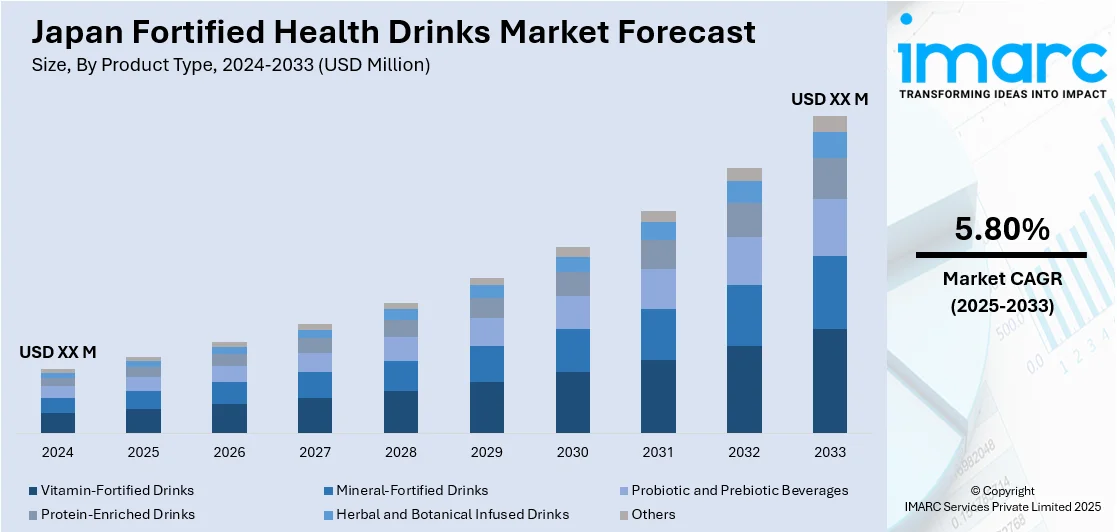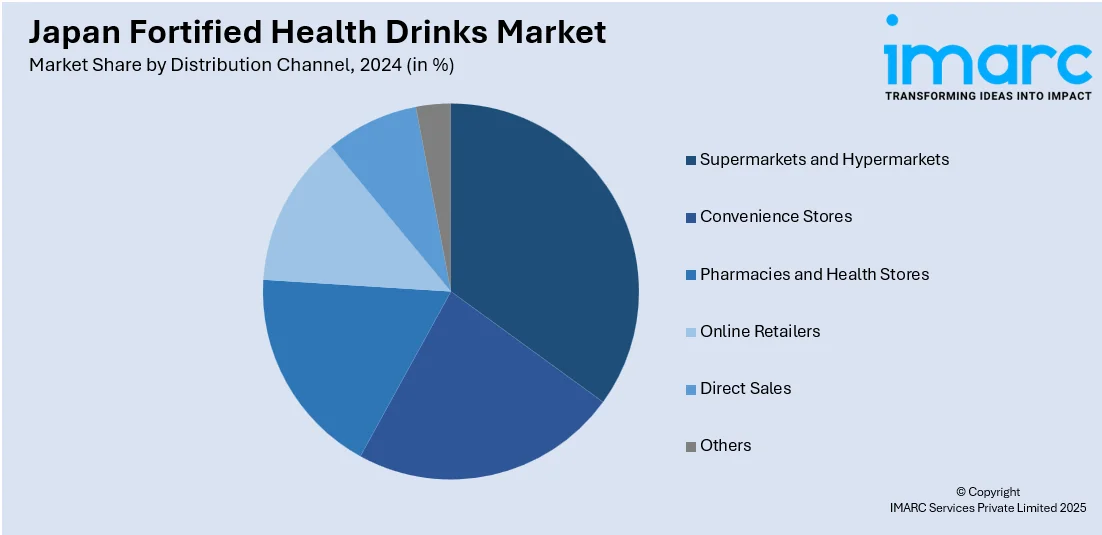
Japan Fortified Health Drinks Market Size, Share, Trends and Forecast by Product Type, Form, Distribution Channel, and Region, 2025-2033
Japan Fortified Health Drinks Market Overview:
The Japan fortified health drinks market size is projected to exhibit a growth rate (CAGR) of 5.80% during 2025-2033. The market is witnessing significant growth, driven by the growing awareness about health and wellness. The demand for plant-based and natural ingredients in fortified drinks is rising, as more consumers turn to healthier, cleaner options. This, along with the rising demand for functional beverages, and Japan's aging population, are further contributing to the Japan fortified health drinks market share.
|
Report Attribute
|
Key Statistics
|
|---|---|
|
Base Year
|
2024
|
|
Forecast Years
|
2025-2033
|
|
Historical Years
|
2019-2024
|
| Market Growth Rate 2025-2033 | 5.80% |
Japan Fortified Health Drinks Market Trends:
Growing Preference for Natural Ingredients
There is a strong and increasing demand for organic and natural health drinks in Japan. With increasing awareness among consumers about the effects of artificial additives, more consumers are looking for products that provide clean, natural ingredients without synthetic chemicals or additives. Such ingredients as organic fruits, herbal extracts, and plant-based proteins are in high demand since they are geared to the increasing trend for sustainable and healthier living. People in Japan are also seeking openness, and they wish to learn precisely what they're putting into their foods and beverages. Therefore, health beverages that incorporate natural sweeteners, vitamins, and minerals derived from plant-based and organic sources are increasing in popularity. This demand is part of a larger consumer movement towards health and wellness, prompting brands to innovate and provide healthier, cleaner drink options. For instance, in May 2025, Nomura Dairy and Probi introduced Japan’s first probiotic-enhanced carrot juice, featuring the natural benefits of carrot juice and fortified with Lactiplantibacillus plantarum 299v. This innovative fermented drink aims to promote digestive health, catering to health-conscious consumers seeking natural and effective gut health solutions in the market. As the focus on natural ingredients continues, this trend is expected to significantly influence the Japanese fortified health drinks market.

Rising Geriatric Population
Japan's aging population is significantly contributing to the growing demand for fortified health drinks, as elderly consumers seek products that promote overall wellness. With an increasing focus on healthy aging, these consumers are particularly interested in fortified drinks that support bone health, cognitive function, and immune system strength. According to industry reports, Japan’s elderly population reached a record 36.25 million, making up nearly 30% of the total population. With women accounting for 20.53 million. Numerous beverages are being fortified with minerals such as calcium, Vitamin D, and magnesium to avoid osteoporosis and increase bone density. Fortified beverages containing antioxidants and brain-enhancing nutrients such as Omega-3 fatty acids are also becoming increasingly popular since they support mental health and preserve brain function. With the aging Japanese population, fortified drinks are becoming a key component in their health regimen every day. These functional beverages provide a convenient and practical solution to meet the special health requirements of elderly people, driving the Japan fortified health drinks market growth.
Japan Fortified Health Drinks Market Segmentation:
IMARC Group provides an analysis of the key trends in each segment of the market, along with forecasts at the country and regional levels for 2025-2033. Our report has categorized the market based on product type, form, and distribution channel.
Product Type Insights:
- Vitamin-Fortified Drinks
- Mineral-Fortified Drinks
- Probiotic and Prebiotic Beverages
- Protein-Enriched Drinks
- Herbal and Botanical Infused Drinks
- Others
The report has provided a detailed breakup and analysis of the market based on the product type. This includes vitamin-fortified drinks, mineral-fortified drinks, probiotic and prebiotic beverages, protein-enriched drinks, herbal and botanical infused drinks, and others.
Form Insights:
- Powdered Drinks
- Ready-to-Drink (RTD)
- Liquid Concentrates
A detailed breakup and analysis of the market based on the form have also been provided in the report. This includes powdered drinks, ready-to-drink (RTD), and liquid concentrates.
Distribution Channel Insights:

- Supermarkets and Hypermarkets
- Convenience Stores
- Pharmacies and Health Stores
- Online Retailers
- Direct Sales
- Others
A detailed breakup and analysis of the market based on the distribution channel have also been provided in the report. This includes supermarkets and hypermarkets, convenience stores, pharmacies and health stores, online retailers, direct sales, and others.
Regional Insights:
- Kanto Region
- Kansai/Kinki Region
- Central/Chubu Region
- Kyushu-Okinawa Region
- Tohoku Region
- Chugoku Region
- Hokkaido Region
- Shikoku Region
The report has also provided a comprehensive analysis of all the major regional markets, which include Kanto Region, Kansai/Kinki Region, Central/Chubu Region, Kyushu-Okinawa Region, Tohoku Region, Chugoku Region, Hokkaido Region, and Shikoku Region.
Competitive Landscape:
The market research report has also provided a comprehensive analysis of the competitive landscape. Competitive analysis such as market structure, key player positioning, top winning strategies, competitive dashboard, and company evaluation quadrant has been covered in the report. Also, detailed profiles of all major companies have been provided.
Japan Fortified Health Drinks Market News:
- In May 2024, Otsuka Pharmaceutical and Arab Otsuka Nutraceuticals launched ORONAMIN C DRINK in Egypt, approved as a Fortify Drink by the NFSA. The carbonated nutritional drink, rich in vitamin C and B vitamins, aims to support healthy lifestyles. ORONAMIN C, first launched in Japan in 1965, is now available in multiple countries.
- In September 2023, Kirin launched two new beverages in Japan: the alcoholic Kirin Tokusei Ginger Ale Sour and a revamped line of sugar-free teas. The ginger ale features sake and 9% ABV, while the teas include probiotics and improved flavors. Both products cater to shifting consumer preferences for health-conscious options.
Japan Fortified Health Drinks Market Report Coverage:
| Report Features | Details |
|---|---|
| Base Year of the Analysis | 2024 |
| Historical Period | 2019-2024 |
| Forecast Period | 2025-2033 |
| Units | Million USD |
| Scope of the Report |
Exploration of Historical Trends and Market Outlook, Industry Catalysts and Challenges, Segment-Wise Historical and Future Market Assessment:
|
| Product Types Covered | Vitamin-Fortified Drinks, Mineral-Fortified Drinks, Probiotic and Prebiotic Beverages, Protein-Enriched Drinks, Herbal and Botanical Infused Drinks, Others |
| Forms Covered | Powdered Drinks, Ready-to-Drink (RTD), Liquid Concentrates |
| Distribution Channels Covered | Supermarkets and Hypermarkets, Convenience Stores, Pharmacies and Health Stores, Online Retailers, Direct Sales, Others |
| Regions Covered | Kanto Region, Kansai/Kinki Region, Central/Chubu Region, Kyushu-Okinawa Region, Tohoku Region, Chugoku Region, Hokkaido Region, Shikoku Region |
| Customization Scope | 10% Free Customization |
| Post-Sale Analyst Support | 10-12 Weeks |
| Delivery Format | PDF and Excel through Email (We can also provide the editable version of the report in PPT/Word format on special request) |
Key Questions Answered in This Report:
- How has the Japan fortified health drinks market performed so far and how will it perform in the coming years?
- What is the breakup of the Japan fortified health drinks market on the basis of product type?
- What is the breakup of the Japan fortified health drinks market on the basis of form?
- What is the breakup of the Japan fortified health drinks market on the basis of distribution channel?
- What is the breakup of the Japan fortified health drinks market on the basis of region?
- What are the various stages in the value chain of the Japan fortified health drinks market?
- What are the key driving factors and challenges in the Japan fortified health drinks market?
- What is the structure of the Japan fortified health drinks market and who are the key players?
- What is the degree of competition in the Japan fortified health drinks market?
Key Benefits for Stakeholders:
- IMARC’s industry report offers a comprehensive quantitative analysis of various market segments, historical and current market trends, market forecasts, and dynamics of the Japan fortified health drinks market from 2019-2033.
- The research report provides the latest information on the market drivers, challenges, and opportunities in the Japan fortified health drinks market.
- Porter's five forces analysis assist stakeholders in assessing the impact of new entrants, competitive rivalry, supplier power, buyer power, and the threat of substitution. It helps stakeholders to analyze the level of competition within the Japan fortified health drinks industry and its attractiveness.
- Competitive landscape allows stakeholders to understand their competitive environment and provides an insight into the current positions of key players in the market.
Need more help?
- Speak to our experienced analysts for insights on the current market scenarios.
- Include additional segments and countries to customize the report as per your requirement.
- Gain an unparalleled competitive advantage in your domain by understanding how to utilize the report and positively impacting your operations and revenue.
- For further assistance, please connect with our analysts.
 Request Customization
Request Customization
 Speak to an Analyst
Speak to an Analyst
 Request Brochure
Request Brochure
 Inquire Before Buying
Inquire Before Buying




.webp)




.webp)












